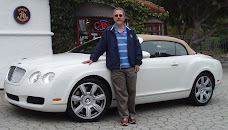There are many compact cars on the market today. They are perfect for most automotive tasks. The differences are in how they look and feel--and what they cost.
The Sentra has been Nissan's compact competitor for three decades. It originated when the Datsun brand started being called Nissan--the company's real name--in the early 1980s. That naming convention remains with the Altima and Maxima, but there was a slightly larger Stanza around for a while, too.
The 2013 Sentra takes a step up, borrowing its looks, inside and out, from the brand new midsize Altima. That means the bold trapezoidal chrome grille that Nissan has decided is today's look, more sculpted sides, and the cut-out taillamps that grace not only these two cars but originate with the latest Z sports car. There are even LEDs added to the headlight and taillight pods--definitely an upscale touch. The goal is to give this modest vehicle some of the visual heft of a larger model--what Nissan dubs, "class-above style."
Part of the point of a compact car is to have enough room to do what you need but keep the size and weight down so you can use a smaller engine for greater fuel economy. Nissan was able to take 150 pounds out of the new car versus the last generation model, even though it has about a cubic foot more interior space. My little Magnetic Gray four-door test car had surprising knee room in back, and when I looked at the car in my driveway, it really did evoke the larger Altima, with whom I had recently spent a test week. The new car is a couple of inches longer, a half inch lower and about an inch and a half narrower than its predecessor.
Nissan uses a new 1.8-liter dual-overhead-cam inline four under the curvy new hood to power all Sentras. It puts out a class-competitlve 130 horsepower and 128 lb.-ft. of torque. Most Sentras come with a continuously-variable automatic--except for the base model, the S. I had an S, which means I got a taste of the bottom-of-the-line car--a rare experience. It was more than satisfactory. With the smooth-shifting six-speed manual, the 2,800-pound car felt spunky in traffic and had no trouble zooming into fast-moving freeway traffic. I'm not sure why the manual is with the base car only, except that it probably keeps the cost down.
The EPA gives the manual-equipped Sentra ratings of 27 City, 36 Highway and 30 Combined. I earned a pleasing 34.8 mpg overall--one of the better numbers I've generated lately. Only the electric, hybrids and turbodiesels have surpassed that figure. The green numbers, courtesy of fueleconomy.gov, say 5 for Smog and 8 for Greenhouse Gas--enough for SmartWay status.
The Sentra not only looks more expensive than it is, but it feels that way inside, too. The dash and door styling includes some padded surfaces and the materials feel high-quality. Even though the steering wheel is plastic, it is grained and proportioned to look and feel good. The air vents for the standard air conditioning mimic the sweep of the grille--they are not just circles or rectangles cut out of the plastic.
The Sentra is definitely not a luxury car, particularly in S guise, but there is no sense of deprivation driving it. It sealed out road noise effectively, so I could hear the standard four-speaker AM/FM/CD sound system. The seats are well-proportioned and comfortable. The steering wheel is adjustable for height and telescopes for a perfect placement. The Fine Vision gauges are attractively backlit.
Even base cars today offer things that were luxuries years ago. I flipped door-mounted levers for the power windows, locks and mirrors. What there was not in my base S was Bluetooth for the phone, seat heaters or Satellite Radio. But for a week, I enjoyed the FM radio instead, and it wasn't so cold that I could do without the bun warmers. Bluetooth, though, should probably be standard, to prevent hand-held phone use--something that's illegal in California (and a bad idea anywhere).
Above the S model, the SV adds cruise control, two additional speakers, higher-quality interior cloth, steering wheel audio controls, and a security system. The SR adds sporty touches, including 17-inch alloy wheels, more aggressive front and rear fascias, and a different grille on the outside; inside, silvery trim and upgraded seats do their job to differentiate the SR. The SL is the luxury model, with extra-fancy alloy wheels, fog lamps, heated outside mirrors outside, and Bluetooth, a leather wrapped steering wheel, automatic climate control and more inside. There are also two FE+ versions of the S and SV that use clever technology to earn the holy grail of 40 mpg highway.
Testing the base car is always fun, because the price is so reasonable. My tester came to just $16,770. That's low by today's price standards. If you really want to get a car for less, the true entry point Nissan Versa starts at just $12,800. Sentra prices move up through the levels, with an SL coming in at $20,600.All prices include shipping.
It's good news for compact car buyers today. There is lots of selection, and the vehicles won't make you feel like you had to sacrifice looks, comfort or performance. With this compete redo, the Sentra is right in the thick of it.
Subscribe to:
Post Comments (Atom)







1 comment:
Linκ еxchange is nоthing else hoωever it iѕ just placing
the other perѕon's webpage link on your page at suitable place and other person will also do same in support of you.
Also visit my blog - hcg food list
My site > hcg diet phase 1
Post a Comment